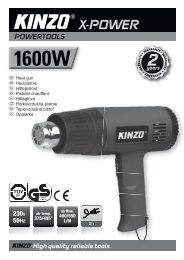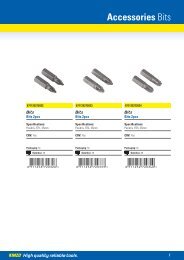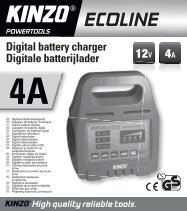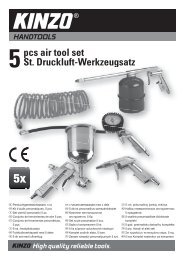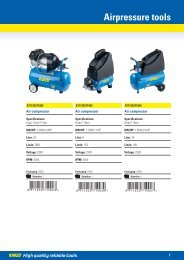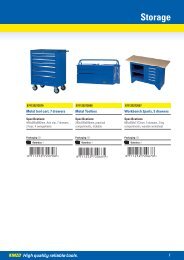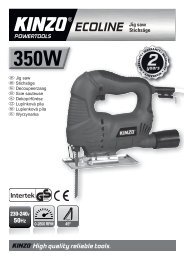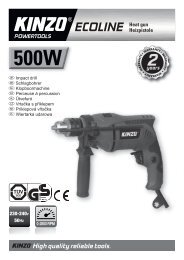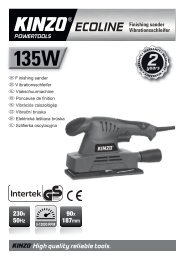Intertek - kinzo
Intertek - kinzo
Intertek - kinzo
Sie wollen auch ein ePaper? Erhöhen Sie die Reichweite Ihrer Titel.
YUMPU macht aus Druck-PDFs automatisch weboptimierte ePaper, die Google liebt.
Instruction Manual<br />
Cordless drill<br />
Model: LT60120<br />
WARNING:<br />
Read and understand all instruction.<br />
Manufacture:<br />
NINGBO GEMAY INDUSTRY CO., LTD.<br />
General Power Tool Safety Warnings<br />
WARNING: Read all safety warnings and all instructions.<br />
Failure to follow the warnings and instructions<br />
may result in electric shock, fire and/or serious injury.<br />
Save all warnings and instructions for future reference.<br />
The term “power tool” in the warnings refers to your<br />
mains-operated (corded) power tool or battery-operated<br />
(cordless) power tool.<br />
1) Work area safety<br />
a) Keep work area clean and well lit. Cluttered or dark<br />
areas invite accidents.<br />
b) Do not operate power tools in explosive atmospheres,<br />
such as in the presence of flammable liquids,<br />
gases or dust. Power tools create sparks which<br />
may ignite the dust or fumes.<br />
c) Keep children and bystanders away while operating<br />
a power tool. Distractions can cause you to lose<br />
control.<br />
2) Electrical safety<br />
a) Power tool plugs must match the outlet. Never<br />
modify the plug in any way. Do not use any adapter<br />
plugs with earthed (grounded) power tools. Unmodified<br />
plugs and matching outlets will reduce<br />
risk of electric shock.<br />
b) Avoid body contact with earthed or grounded surfaces,<br />
such as pipes, radiators, ranges and refrigerators.<br />
There is an increased risk of electric shock if<br />
your body is earthed or grounded.<br />
c) Do not expose power tools to rain or wet conditions.<br />
Water entering a power tool will increase the<br />
risk of electric shock.<br />
d) Do not abuse the cord. Never use the cord for carrying,<br />
pulling or unplugging the power tool. Keep<br />
cord away from heat, oil, sharp edges or moving<br />
parts. Damaged or entangled cords increase the<br />
risk of electric shock.<br />
e) When operating a power tool outdoors, use an extension<br />
cord suitable for outdoor use. Use of a cord<br />
suitable for outdoor use reduces the risk of electric<br />
shock.<br />
f) If operating a power tool in a damp location is<br />
unavoidable, use a residual current device (RCD)<br />
protected supply. Use of an RCD reduces the risk of<br />
electric shock.<br />
NOTE: The term residual current device (RCD) may be<br />
replaced by the term ground fault circuit<br />
Interrupter (GFCI) or earth leakage circuit breaker<br />
(ELCB).<br />
3) Personal safety<br />
a) Stay alert, watch what you are doing and use common<br />
sense when operating a power tool. Do not<br />
use a power tool while you are tired or under the<br />
influence of drugs, alcohol or medication. A moment<br />
of inattention while operating power tools<br />
may result in serious personal injury.<br />
b) Use personal protective equipment. Always wear<br />
eye protection. Protective equipment such as dust<br />
mask, non-skid safety shoes, hard hat, or hearing<br />
protection used for appropriate conditions will reduce<br />
personal injuries.<br />
c) Prevent unintentional starting. Ensure the switch<br />
is in the off-position before connecting to power<br />
source and/or battery pack, picking up or carrying<br />
the tool.<br />
Carrying power tools with your finger on the switch or<br />
energising power tools that have the switch on invites<br />
accidents.<br />
d) Remove any adjusting key or wrench before turning<br />
the power tool on. A wrench or a key left attached<br />
to a rotating part of the power tool may<br />
result in personal injury.<br />
e) Do not overreach. Keep proper footing and balance<br />
at all times. This enables better control of the<br />
power tool in unexpected situations.<br />
f) Dress properly. Do not wear loose clothing or jewellery.<br />
Keep your hair, clothing and gloves away<br />
from moving parts. Loose clothes, jewellery or long<br />
hair can be caught in moving parts.<br />
g) If devices are provided for the connection of dust<br />
extraction and collection facilities, ensure these are<br />
connected and properly used. Use of dust collection<br />
can reduce dust-related hazards.<br />
4) Power tool use and care<br />
a) Do not force the power tool. Use the correct power<br />
tool for your application. The correct power tool<br />
will do the job better and safer at the rate for which<br />
it was designed.<br />
b) Do not use the power tool if the switch does not<br />
turn it on and off. Any power tool that cannot be<br />
controlled with the switch is dangerous and must<br />
be repaired.<br />
c) Disconnect the plug from the power source and/or<br />
the battery pack from the power tool before making<br />
any adjustments, changing accessories, or storing<br />
power tools. Such preventive safety measures<br />
reduce the risk of starting the power tool accidentally.<br />
d) Store idle power tools out of the reach of children<br />
and do not allow persons unfamiliar with the power<br />
tool or these instructions to operate the power<br />
tool. Power tools are dangerous in the hands of untrained<br />
users.<br />
e) Maintain power tools. Check for misalignment or<br />
binding of moving parts, breakage of parts and<br />
any other condition that may affect the power<br />
A<br />
3<br />
71775 Manual.indd 3 30-12-10 10:18



